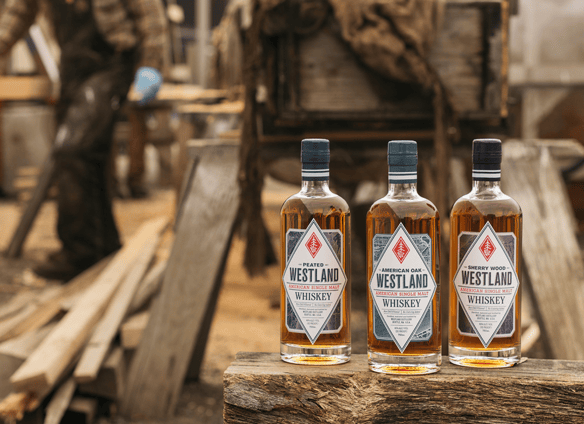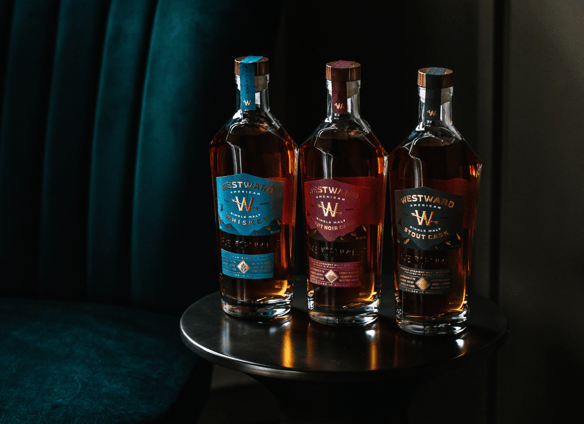AMERICAN SINGLE MALT WHISKY:
A COMPLETE GUIDE
BECOME AN EXPERT IN AMERICAN SINGLE MALT
WHAT IS AMERICAN SINGLE MALT WHISKY?
American Single Malt Whisky is now formally recognized under the following criteria:
- 100% Malted Barley: Crafted exclusively from 100% malted barley, delivering a rich and diverse array of flavors.
- Mashed, Distilled, and Aged in the United States: Every step of the process, from mashing to aging, takes place on U.S. soil.
- Single Distillery: Distilled entirely at one U.S. distillery to ensure the integrity and provenance of each bottle.
- Distillation Proof: Distilled to no more than 160° proof, preserving the character of the grain.
- Oak Barrel Aging: Stored in oak barrels—used, uncharred new, or charred new—with a maximum capacity of 700 liters, ensuring the perfect interaction between whisky and wood.
- Bottling Proof: Bottled at a minimum of 80° proof, adhering to the expectations of whisky enthusiasts worldwide.
- Caramel Coloring: Allows the use of caramel coloring, provided it is disclosed on the label
The “Straight” Designation
For whiskies aged a minimum of two years in specified oak barrels, the "Straight American Single Malt Whisky" designation is now available. This designation highlights the quality and craftsmanship of products meeting this enhanced aging standard.
Transparency and Innovation
The TTB’s final rule permits limited use of caramel coloring in American Single Malt Whisky—but only if disclosed on the label. This ensures clarity for consumers while aligning with practices common in other single malt whisky categories worldwide.
Transition Period for Existing Labels
Producers have a five-year transition period, until January 19, 2030, to update labels and processes to meet these new standards. This ensures the smooth adoption of the updated regulations without disrupting the availability of beloved products already on the market.
Why This Matters
The formal recognition of American Single Malt Whisky as a distinct category provides a benchmark for quality and consistency while celebrating the creativity and craftsmanship of U.S. distilleries. Much like Scotch whisky or Japanese single malts, American Single Malt Whisky now has clear standards that build consumer trust and elevate its reputation on the global stage.
A Commitment to Excellence
At Virginia Distillery Company, we’re thrilled to see the TTB’s recognition of the American Single Malt Whisky category, as it mirrors our commitment to producing exceptional whiskies that honor tradition while embracing innovation. We invite you to explore the rich flavors and stories behind our American Single Malt Whisky offerings—crafted with care, rooted in heritage, and defined by excellence.
LEARN EVERYTHING YOU NEED TO KNOW ABOUT AMERICAN SINGLE MALT WHISK(E)Y
The category of American single malt whisky is on the rise. According to the IWSR, American single malt whiskies grew 22.2% year-over-year in 2018, with more bottles hitting the market every day. Consumers are making space in their cabinets and on their shelves for this distinctly American offering.
For craft distilleries, American single malt represents a chance to stand out in a crowded market. Meanwhile, more established distilleries are using the category to expand and differentiate their portfolios. It’s an exciting time for both whisky lovers and distillers alike.
That said, education around the category is still catching up. What makes a whisky an American single malt? How is it made, how does it taste, and what should you look for when buying a bottle?
This page serves as your go-to guide—an introduction to the world of American single malt whisky and everything you need to know about this fast-growing category.
This guide was last updated on January 7th, 2024.
TABLE OF CONTENTS
WAIT... IS IT WHISKY OR WHISKEY?
Tracing whisky's roots back to Scotland and Ireland, the original names for water of life, “uisge beatha” and “uisce beatha” respectively, were remarkably similar. As the Gaelic languages were Anglicized, the phrase was eventually shortened to simply the word for water: “whisky” in Scotland and “whiskey” in Ireland.
The Irish immigrants who traveled to the new world brought not only the knowledge of how to make whiskey with them, they also brought their spelling. For the rest of the world, and many American distilleries who trace their roots back to Scotland or intended to maintain a more global spelling, whisky is their spelling of choice.
In a nod to a more universal spelling and for simplicity’s sake, this guide will use whisky as the spelling for all instances apart from specific brand names. While Ireland and many American distilleries include an “e” in their spelling, even Maker’s Mark, George Dickel, Old Forester and Balcones are among the ranks of those who leave out the “e.”
HOW WHISKY IS MADE: A QUICK OVERVIEW
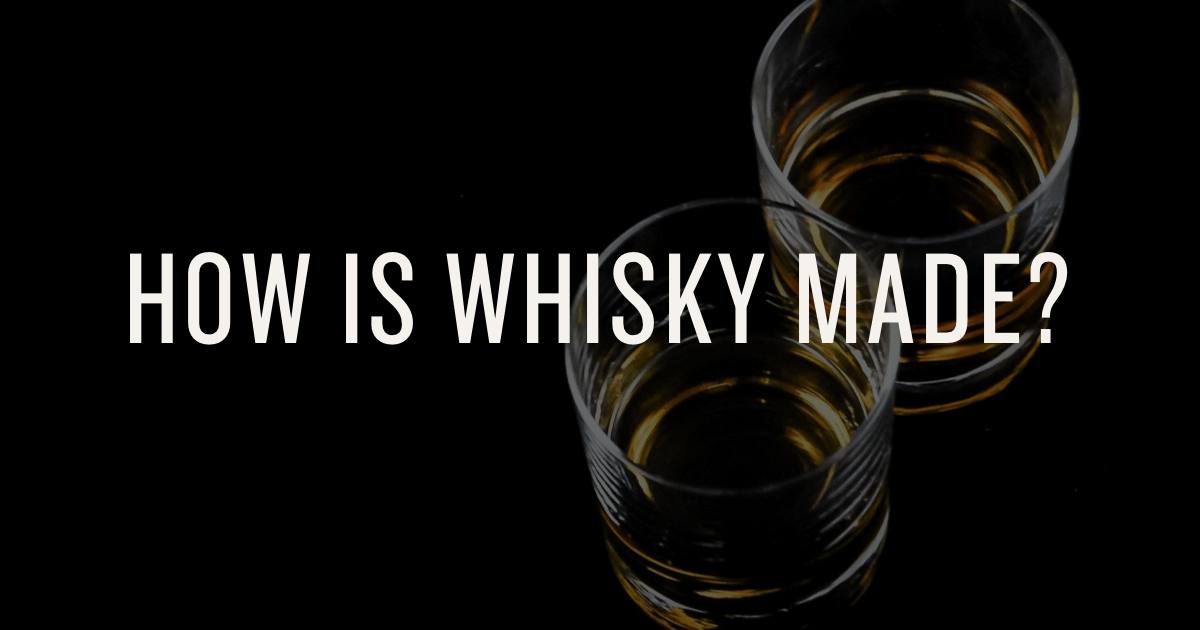
Before jumping into what makes a whisky an American single malt, let’s cover our bases and do a whisky 101 overview. Simply defined, whisky is an alcoholic product made for consumption that's at least 40% alcohol by volume (ABV) created by distilling fermented grain mash. Only three ingredients are needed to produce whisky: yeast, water, and grain.
Sounds easy, right?
But ask any distiller what it takes to make whisky: chances are they’ll tell you producing whisky is one part art and another part science. Think about it for a second: to turn these three ingredients into a spirit that has a complex array of aromas and flavors is quite the feat.
There are many factors that go into producing the variety of tastes of whiskies you enjoy: from the type of grain used, the yeast profile, and the water, but also various distillation techniques, equipment used, barrel aging and finishing techniques, how the whisky is married before bottling, and the timing of each and every process. That's why if you pour yourself five different whiskies produced by five different distilleries, they'll all have unique tastes.
The four grains most commonly used for whisky production are corn, rye, wheat and barley. Each grain produces a whisky with different taste. As an example, whisky produced using corn will taste sweeter compared to a whisky produced using rye, which generally takes on a more spicy profile.
There are slight differences in the process of producing whisky depending on the grain used, but in general, the process of creating whisky is as follows:
MALTING. The process in which the grain is moistened, allowing it to germinate, and then heated and dried to stop its malting process.
MILLING. The process in which the malted grains are ground up into three parts - the husks, the middle, and the flour - that creates a powdery composition known as the grist.
MASHING. The process in which the grist is combined with water of varying hot temperatures in a large container called a mash tun, producing mash or wort.
FERMENTATION. The process in which yeast is added to the mash (or wort if the spent grains are removed first), converting sugar in the mash to alcohol, producing unhopped beer of approximately 8% alcohol by volume, known as the wash.
DISTILLATION. The process in which the wash is heated up in a still, where the alcohol is separated and removed from the wash, creating the spirit that will be placed into casks to mature and become whisky.
MATURATION. The distilled spirit is placed in a variety of oak barrels and matures for a certain length of time, where it takes on its flavor and color profiles.
VATTING. After maturation, whiskies from different casks may be combined and given a water addition, both of which can add to the whisky’s characteristics and final taste.
BOTTLING. The whisky is finally put into bottles at or above 40% ABV for your consumption.
DEFINING AMERICAN SINGLE MALT WHISKY
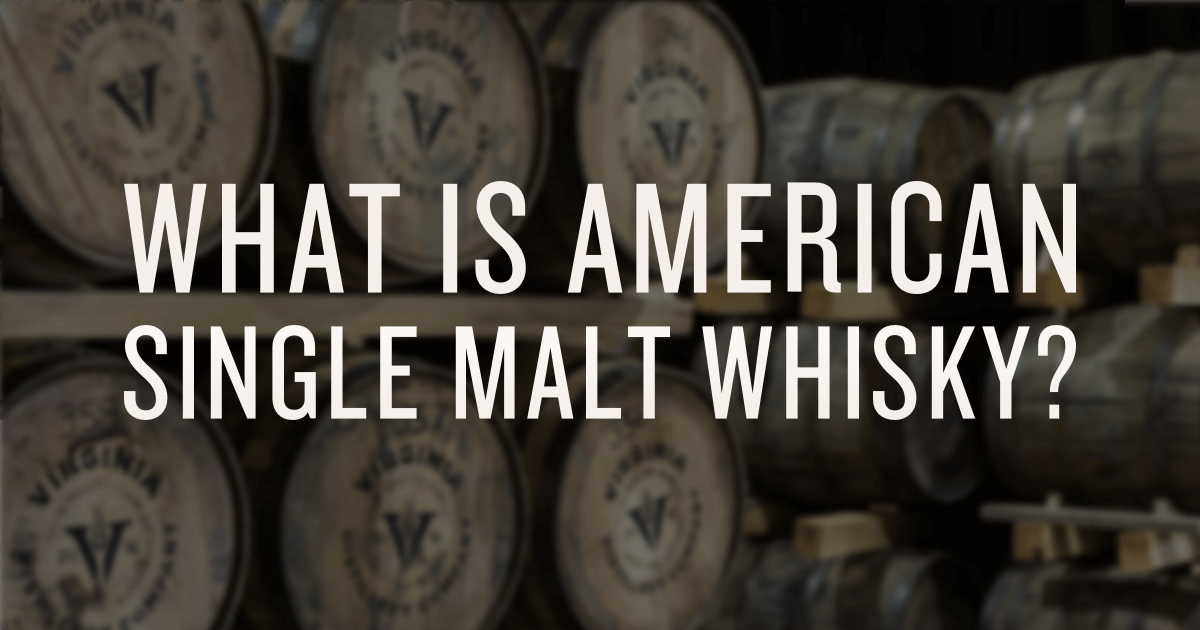
Like many other spirits, whisky and its varying subcategories are often defined by laws of the nations where it’s produced. The differences in definitions include minimum aging requirements and naming standards, to name a few.
To define what American single malt whisky is, let’s break down each word, working backwards starting with ‘whisky’.
WHISKY
In summary, whisky is an alcoholic beverage made from distilling fermented grain mash that’s at least 40% ABV. Worldwide, this is a fairly agreed upon standard.
MALT WHISKY
To classify what defines a malt whisky, it depends on the country where the whisky is produced:
- In Scotland and Ireland, for a whisky to be called a malt whisky, the spirit must be produced using 100% malted barley.
- In the United States however, according to the Standards of Identity for Distilled Spirits, a spirit defined as a malt whisky must be produced using a mash bill of at least 51% malted barley.
SINGLE MALT WHISKY
To classify as a single malt whisky, it’s generally accepted that the whisky must be produced at a single distillery.
According to the Scotch Whisky Regulations 2009, Single Malt Scotch Whisky is defined as a whisky with a mash bill consisting of 100% malted barley, produced from only water and malted barley at a single distillery by batch distillation in pot stills.
In the United States, there’s a general agreement that a Single Malt Whisky follows in the footsteps of the regulations of Scotland, where the whisky must be 100% malted barley produced at a single distillery. However, there are no laws and regulations in place that prevent a distillery in the United States from calling their product a “Single Malt Whisky” if what’s being produced is produced using a mash bill of 51% barley.
AMERICAN SINGLE MALT WHISKY
To be classified as an American single malt whisky, the Alcohol and Tobacco Tax and Trade Bureau (TTB) now recognizes a specific standard of identity. Beginning January 19, 2025, American single malt whisky must be:
- 100% Malted Barley: Crafted exclusively from 100% malted barley, delivering a rich and diverse array of flavors.
- Mashed, Distilled, and Aged in the United States: Every step of the process, from mashing to aging, takes place on U.S. soil.
- Single Distillery: Distilled entirely at one U.S. distillery to ensure the integrity and provenance of each bottle.
- Distillation Proof: Distilled to no more than 160° proof, preserving the character of the grain.
- Oak Barrel Aging: Stored in oak barrels—used, uncharred new, or charred new—with a maximum capacity of 700 liters, ensuring the perfect interaction between whisky and wood.
- Bottling Proof: Bottled at a minimum of 80° proof, adhering to the expectations of whisky enthusiasts worldwide.
- Caramel Coloring: Allows the use of caramel coloring, provided it is disclosed on the label
Previously, there were no binding regulations preventing a distillery from labeling a product “American Single Malt Whisky,” even if it didn’t meet these standards. For example, a whisky made from 70% malted barley and 30% wheat, or one distilled at multiple locations, could still carry the label.
With the new regulation in place, the TTB ensures that the label “American Single Malt Whisky” reflects these clear criteria, giving consumers confidence in the product’s identity and quality.
THE IMPORTANCE OF THE AMERICAN SINGLE MALT WHISKEY COMMISSION
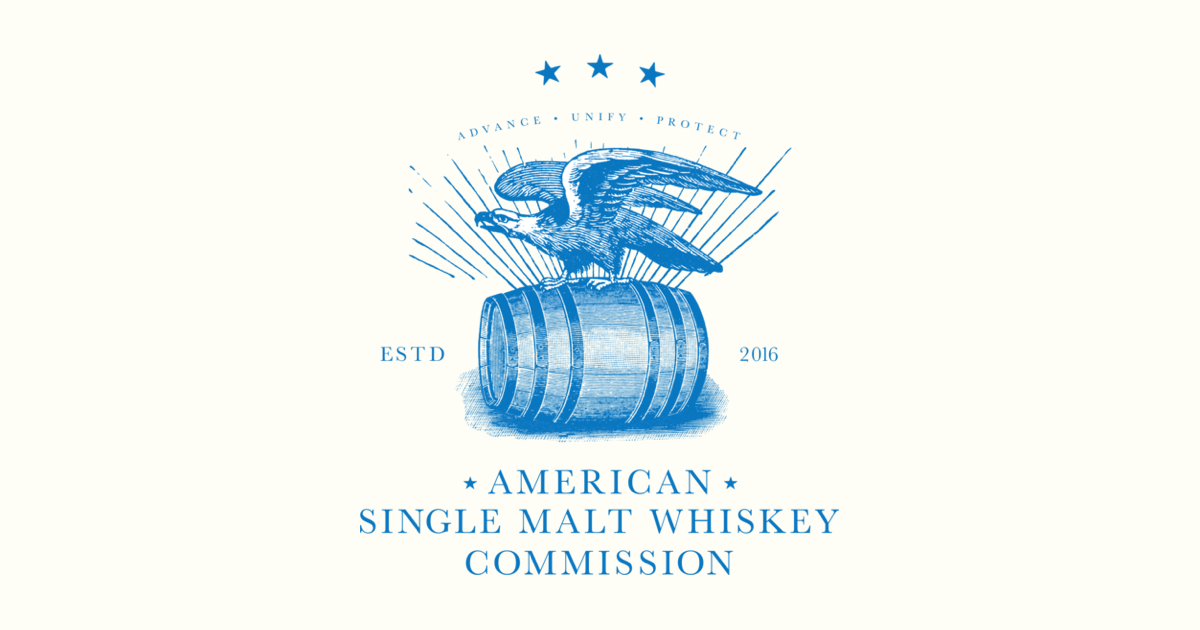
Bourbon whisky has long been protected by strict definitions outlined in The Federal Standards of Identity for Distilled Spirits, with trade agreements ensuring the term "Bourbon" is reserved for products made in the United States. Similarly, Scotch is governed by The Scotch Whisky Regulations 2009, which outline rigorous standards for distilleries in Scotland, including subcategories like Single Malt Scotch Whisky and Blended Malt Scotch Whisky.
In the United States, the rise of American single malt whisky called for a similar approach. Enter the American Single Malt Whiskey Commission (ASMWC), a group formed to protect, educate, and promote this growing category both at home and internationally.
The ASMWC helped define the category with six core guidelines:
- Made from 100% malted barley
- Distilled entirely at one distillery
- Mashed, distilled, and matured in the United States
- Matured in oak casks with a capacity not exceeding 700 liters
- Distilled to no more than 160 proof (80% ABV)
- Bottled at greater than 80 proof (40% ABV)
- Allows the use of caramel coloring, provided it is disclosed on the label
As of December 18, 2024, the Alcohol and Tobacco Tax and Trade Bureau (TTB) officially recognizes American single malt whisky as its own category of whisky, adding it to the Standards of Identity for Distilled Spirits. This means American single malt whisky now holds its place alongside Bourbon and Scotch as a defined and protected style.
Cheers to this milestone! You can read the TTB's final rule here.
SCOTCH WHISKY VS. AMERICAN SINGLE MALT
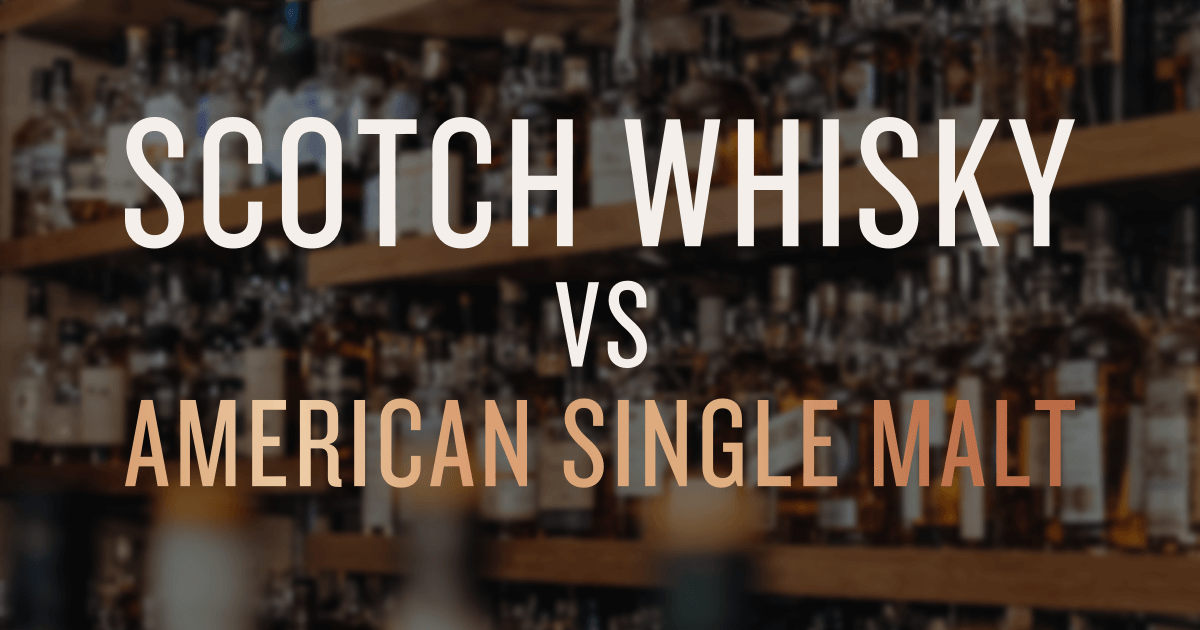
How does American single malt whisky compare to Scotch Whisky? It’s a question commonly asked at tastings while educating those interested in the American single malt category.
WHAT IS SCOTCH WHISKY?
Learn about the official documents that define Scotch, The Scotch Whisky Regulations 2009. Feel free to read this 83-page PDF, but for a cliff note version, Scotch can be generalized by the following seven rules:
- Made from water, malted barley, and yeast
- Distilled to no more than 94.8% ABV
- Matured in oak casks of a capacity not exceeding 700 liters
- Mashed, distilled, and matured in Scotland
- Matured for more a minimum of 3 years in an excise warehouse or a permitted place
- No substance added except water and plain caramel coloring
- Bottled at or greater than 80 proof (40% ABV)
Scotch Whisky also has a number of subcategories, with the two popular subcategories being Single Malt Scotch Whisky and Blended Scotch Whisky.
Single Malt Scotch Whisky is defined as a single malt whisky from Scotland produced at one distillery using 100% malted barley. Many iconic Scotch brands are single malt producers, including The Balvenie, Bruichladdich, The Dalmore, Glenfiddich, The Glenlivet, Glenmorangie, Highland Park, Laphroaig, The Macallan, and Talisker to name a few.
Blended Scotch Whisky is defined as a whisky combining one or more grain whiskies with one or more malt whiskies. Many iconic Scotch brands are blended Scotch producers, including Ballantine's, Chivas Regal, Dewars, The Famous Grouse, Johnnie Walker, Whyte & Mackay, and William Grant & Sons. Blended Scotch is a huge industry: 90% of the final whisky produced in Scotland is classified as Blended Scotch Whisky.
Other subcategories of Scotch include Blended Malt Scotch Whisky (formerly known as “vatted”, containing a combination of only malt whiskies from different distilleries), Single Grain Scotch Whisky, and Blended Grain Scotch Whisky.
Scotch is a classic example of a product that’s well-known internationally. When you think of Scotland, you might think of the Loch Ness monster, bagpipes, and Scotch. Needless to say, Scotch is a huge export of Scotland and a significant part of Scotland’s economy. That’s why it’s very important for them to protect the definition of Scotch.
SIMILARITIES & DIFFERENCES OF SCOTCH AND AMERICAN SINGLE MALT WHISKY
The subcategory of Scotch that most closely matches the definition of American single malt whisky is Single Malt Scotch Whisky. Both are made at a single distillery using 100% malted barley, with similar distillation and maturation processes. American single malt must now meet specific TTB standards, including maturing in oak casks with a capacity of no more than 700 liters, which often includes ex-Bourbon casks alongside sherry, port, and wine casks.
While Scotch is sometimes associated with peat—thanks to world-famous brands like Laphroaig, Lagavulin, Talisker, and Bruichladdich—not all Scotch is peated. Similarly, peated American single malts, like Westland Distillery's Peated American Single Malt Whiskey or Santa Fe Spirits' Colkegan Single Malt Whiskey (mesquite-smoked), exist but are less common compared to peated Scotch whiskies.
Another key difference is age statements. Scotch whiskies often showcase age prominently, like Glenfiddich 12 or Lagavulin 16, signaling the years spent maturing in casks. In contrast, age statements are less common in American single malts for two reasons:
- Climate: The more dramatic temperature ranges in the U.S. allow whisky to mature more quickly compared to Scotland.
- Timing: Many American single malt producers are relatively young, with most starting after 2010, so 10+ year-old whiskies are rare.
That said, the TTB requires age statements for any whisky aged less than four years, so you’ll see some younger American single malts clearly labeled.
Finally, it’s worth noting that the length of maturation doesn’t always equate to better quality. American single malt whiskies excel at showcasing bold flavors that often develop in less time, thanks to innovative techniques and the unique American climate.
A TASTE COMPARISON OF SCOTCH AND AMERICAN SINGLE MALT WHISKY
Scotch and American single malt may be similar in makeup, though there are a wider range of Scotch products available in relation to American single malt products. Scotch Whisky identity extends to five (six, if you separate the islands) specific regions, which are noted for distinct styles: the Lowlands, the Highlands, Campbeltown, Speyside and Islay.
- The Lowland’s smooth malts offer lighter notes of grass, honeysuckle, toffee and cinnamon.
- The Highland region, which generally includes the islands apart from Islay and formerly held Speyside, showcases a range of lighter whiskies all the way through salty coastal malts.
- Campbeltown whiskies are typically robust and flavorful. Fruit, vanilla and toffee notes are often accentuated with a hint of salt and smoke.
- Speyside is Scotland’s most densely populated region of distilleries, with whiskies known for moderate to zero peat. Typical expressions showcase soft caramel, fruits, vanilla and spice.
- Windswept Islay’s whiskies are recognized the world over for the influence of peat, even though many of Islay’s distilleries obtain their malt from other regions of Scotland.
These geographically focused designations have yet to be set in the United States, even though the geography and climate in the United States is more diverse than what can be found in the United Kingdom. American single malt producers have been able to showcase a wide array of styles thanks largely to dramatic temperature swings, humidity impacts and a unique selection of aging techniques.
American single malt distilleries such as Texas’s Balcones Distilling highlight the shorter aging time needed thanks to their intense, hot summers. West coast single malt producers like Washington state’s Westland Distillery have been known to utilize unique regional elements such as peat or region specific wood for their barrels. At Virginia Distillery Company, we’ve been tracking seasonal climate impacts on barrel aging in Virginia’s humid, subtropical climate. These distinctive production elements contribute to a concept of provenance that makes its way into the whisky’s aromas and taste.
Many American single malt distilleries have been known to utilize new oak, in contrast to the used oak favored by Scottish distilleries. Some American single malt producers, such as Tuthilltown Spirits’ Hudson Single Malt age their whisky in small American Oak barrels to further decrease aging time and significantly play up the new oak wood notes in their whisky, a striking contrast to Scottish single malts.
LEARN MORE ABOUT SCOTCH: DOCUMENTARIES
Want to learn more about Scotch? Below are two highly recommended documentaries:
BOURBON WHISKY VS. AMERICAN SINGLE MALT
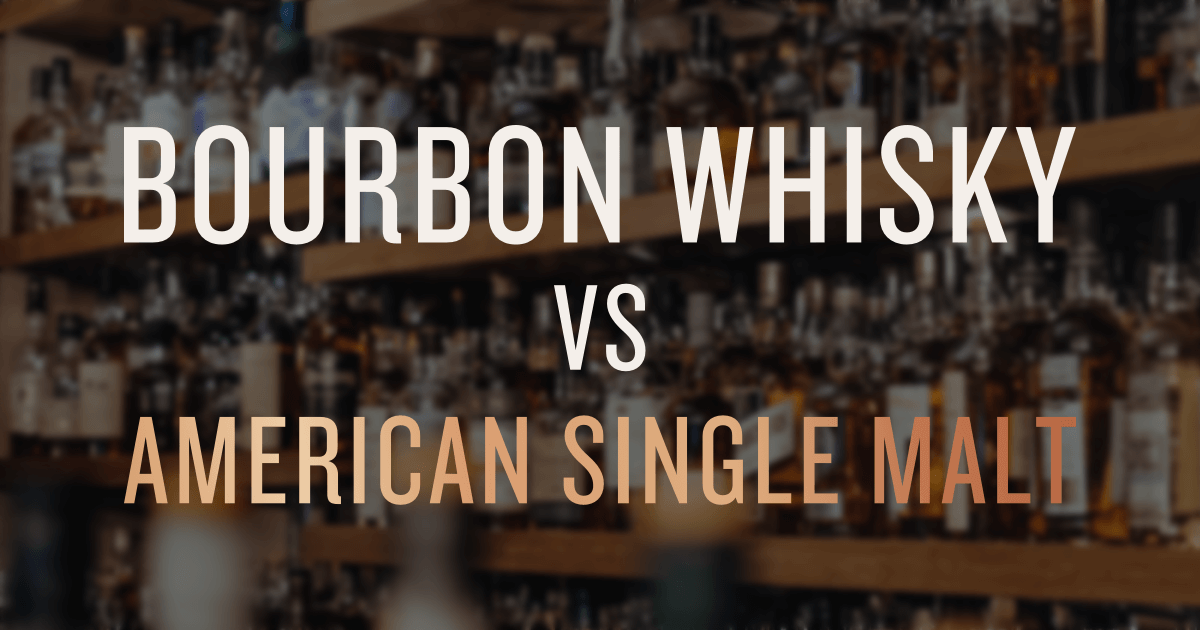
How does American single malt whisky compare to Bourbon whisky? Due to the popularity of Bourbon in the United States, this is a question often asked at tastings while educating consumers on the American single malt category.
WHAT IS BOURBON WHISKY?
Similar to Scotch and The Scotch Whisky Regulations 2009, the United States has official documents that define Bourbon called The Federal Standards of Identity for Distilled Spirits (27 CFR 5). For a cliff note version, Bourbon can be generalized by the following nine rules:
- The grain mixture (mash bill) must be at least 51% corn
- Distilled to no more than 80% ABV (160 proof)
- Matured in new, charred oak barrels
- The entry proof cannot be greater than 62.5% ABV (125 proof)
- Bottled greater than 80 proof (40% ABV)
- Must be produced in the United States (not just Kentucky)
- If it’s aged for a minimum of two years, it qualifies as Straight Bourbon
- An age statement must be produced on the bottle if it has been aged for less than 4 years
- If there's an age statement produced on the bottle, it must be the age of the youngest whisky in the bottle
“I like Bourbon a lot, but I’m not a huge fan of whisky” is something we hear repeated out in the field more often than you think. It’s a testament of how popular bourbon has become. To clarify, bourbon is a type of whisky, not the other way around.
Bourbon is a distinctive product of the United States, sometimes nicknamed ‘America’s Native Spirit’. You might know it as the drink your father or grandfather would have to wind down their day. Bourbon is a big deal in the United States; its rich history and legacy arguably had a large part in shaping America as it is today.
Bourbon is aligned to Scotch in a similar manner in that if a Canadian distillery produced a product that met all the Bourbon standards of identity outlined above, it would still have to be labeled something else other than Bourbon since it’s not made in the US. It would be enforced per the United States and Canada trade agreements in place.
SIMILARITIES & DIFFERENCES OF BOURBON AND AMERICAN SINGLE MALT WHISKY
Bourbon and American Single Malt Whisky are both great whiskies served neat or on the rocks. They’re both close to the same strength with a minimum of 40% ABV and both matured in oak barrels.
But there are some differences. Bourbon has a mash bill of at least 51% corn and must be matured in new, charred oak barrels. American single malt is 100% malted barley and can be matured in used oak barrels, sometimes ex-Bourbon barrels, sometimes different barrels altogether or new oak casks.
Bourbon production is concentrated: 95% of Bourbon is produced in Kentucky and is popular as a southern spirit. American Single Malt Whisky is much more widespread, produced in distilleries from Massachusetts, to California, and everywhere in between.
A TASTE COMPARISON OF BOURBON AND AMERICAN SINGLE MALT WHISKY
The base ingredients and the methods of production and aging dictate that there will be several key differences in the taste of Bourbon vs. American single malt.
Bourbon’s dominant grain, corn, is loaded with starch and will contribute a sweetness due to the amount of sugar that can be extracted from each kernel of corn. The addition of wheat or rye into a Bourbon’s mash bill will add notes of soft fruit and floral spice respectively. Bourbon is also made using a sour mash process and even the fermentation and shape of the stills (commonly column or hybrid), will impact the amount of congeners and thus flavors in a Bourbon. Aging in new charred oak means notes of vanilla, cherry, barrel spice and tannin are common notes found in Bourbon.
American single malt is made with 100% malted barley, which contributes both fruity and nutty character to a whisky. The aromatics of barley are typically complex and soft, and the mouthfeel contributed to barley will often be round. With many American single malts distilled in copper pot stills, the unique reflux patterns will result in a character-driven spirit.
Where Bourbons are restricted to aging in new charred oak, American single malts have the freedom to capitalize on the gentler interactions of second, or even third use former Bourbon barrels. American single malts may also use Sherry casks from Spain, Port casks from Portugal, Caribbean rum casks, even unique wine casks or new charred oak barrels.
This freedom points to a potential plethora of flavor profiles for the American single malt category. Often, consumers can expect a more subtle, layered complexity in American single malts with notes ranging from soft stone fruits, to rich toffees and dried fruit, to earthy chocolate and barrel spice, with endless possibilities of flavor and aroma combinations along the way. Water, yeast and barley may sound like a simple recipe, but the steps along the route guarantee that the taste will be anything but simple.
LEARN MORE ABOUT BOURBON: DOCUMENTARIES
Want to learn more about Bourbon? Below are two highly recommended documentaries.
While it’s not about Bourbon specifically, the Ken Burns documentary on Prohibition (available on Netflix) is a very telling series describing the history of alcohol in the United States.
A BRIEF HISTORY OF AMERICAN SINGLE MALT

One of the early pioneers of American single malt was Steve McCarthy, who started Clear Creek Distillery in Portland Oregon in the 1980s. In the next decade, McCarthy’s Oregon Single Malt Whiskey came onto the scene, breaking ground for the American single malt category. That was followed up by St. George Spirits producing an American single malt in 2000, Stranahan’s in 2004, and then Balcones in 2008.
So why has it taken so long for 100% malted barley whisky to be a thing in the United States when Scotland has been doing it for centuries?
James Anderson was a significant player in the American whisky field, whose story mirrored that of many American distillers. A successful barley farmer in Scotland, Anderson spent years honing his craft. In addition to supplying barley to some of the largest Scottish whisky distilleries, he also owned his own whisky distillery and mill. In the early 1790s Anderson moved to the newly formed United States with his family. He was recruited to become George Washington’s farm manager at Virginia’s Mount Vernon in 1796.
James Anderson wasted little time before approaching Washington with a plan to open a whisky distillery. Anderson’s background with barley and his knowledge of how well it suited whisky production was met with an obstacle: the rocky soil at Mt. Vernon. While hardy rye was plentiful, barley struggled to grow in the challenging soil. In true American spirit, Anderson experimented with rye and corn, while still incorporating as much barley as he could obtain. Researchers have discovered that the whisky’s mash bill from 1798-1799 was 60% rye, 35% corn and 5% barley.
Visit any Bourbon distillery today and ask what their rye or Bourbon mash bill is and they will likely mention at least 5% barley as well. Malted barley is the one grain that contains the crucial enzyme amylase. Amylase is special because it can split starches - not just in barley, but in other grains too. When we talk about grain being one of the three core ingredients in a whisky, it’s really the grain’s starch that is needed. Thanks to barley’s enzyme amylase, we're able to access the sugars needed for fermentation. And as we all know, without fermentation there would be no alcohol.
Expensive as barley may be and tricky as it is to grow, barley has been hailed the world over as a premium grain: the best at converting starches to fermentation ready sugars. It is also heralded as a romantic trailblazer from the first great whiskies distilled in Scotland and Ireland, and a delicious component that adds malty sweetness and nutty, biscuity notes to a whisky.
Thanks to modern technology and increased education from the traditions of the Old World, American distillers are beginning to turn their attention once more to barley.
As of January 19, 2025, the Alcohol and Tobacco Tax and Trade Bureau (TTB) officially recognized American single malt whisky as a distinct category. This landmark ruling ensures consistency and transparency for the category, defining it with the following criteria:
- Made from 100% malted barley
- Distilled entirely at one U.S. distillery
- Mashed, distilled, and matured in the United States
- Matured in oak casks with a capacity not exceeding 700 liters
- Distilled to no more than 160 proof (80% ABV)
- Bottled at no less than 80 proof (40% ABV)
- Allows the use of caramel coloring, provided it is disclosed on the label
This decision is a game-changer for both consumers and distillers, offering a clearly defined identity for American single malt whisky while paving the way for further innovation in this growing category.
PERTAINING TO THE TOPIC OF STILL TYPES
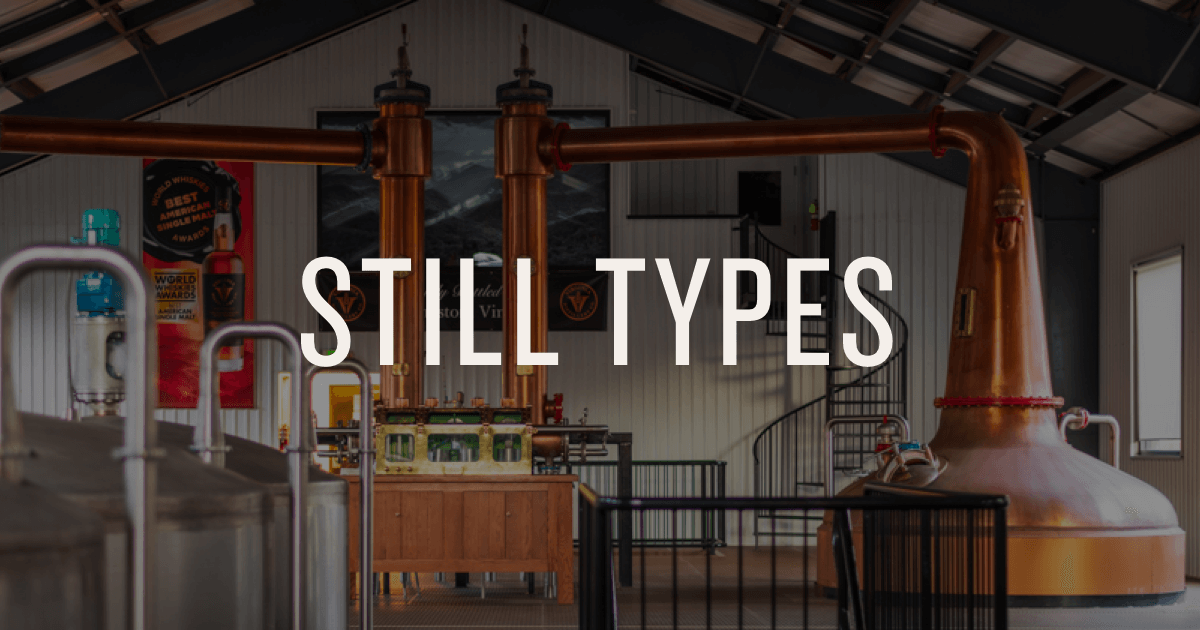
Single malt whiskies are traditionally distilled in copper pot stills. Copper, an excellent conductor of heat, is also helpful in removing undesirable sulphur compounds from a spirit. The shape, height and size of a still can play a large part in determining the character and flavors of the final spirit.
Pot stills work through a batch process where a fermented beer or “wash” is heated up in the still. Because alcohol boils at a lower temperature than water, it separates in a gradual reflux, turning into a vapor, before condensing back into a liquid to be gathered and then sent on to a second distillation. Many distilleries have multiple pot stills and refer to the first still as the wash still, and the subsequent still(s) as the spirit still.
Other smaller distilleries clean out their single pot still before reusing for a second distillation. Some distilleries, particularly in Ireland, but also some Scottish distilleries like Auchentoshan, triple distill their whiskies. Each distillation increases the ABV of a spirit, but distilling more than three times is generally thought to strip out more character and flavor in a spirit than would be desirable.
The column or continuous still is an efficient way to achieve a high proof spirit in a relatively hands off manner. This is most ideal for vodkas and gins, as spirits distilled in this manner typically have fewer congeners than their pot distilled counterparts, and thus less flavor character.
Multiple column stills take things even further when it comes to achieving a pure-strength spirit, and hybrid stills (also referred to as pot and column stills) fall in the middle between the efficiency of a continuous still and the character retention of the pot still method. Thus, you’ll find that many American single malts are distilled in copper pot stills.
PERTAINING TO THE TOPIC OF CASK TYPES
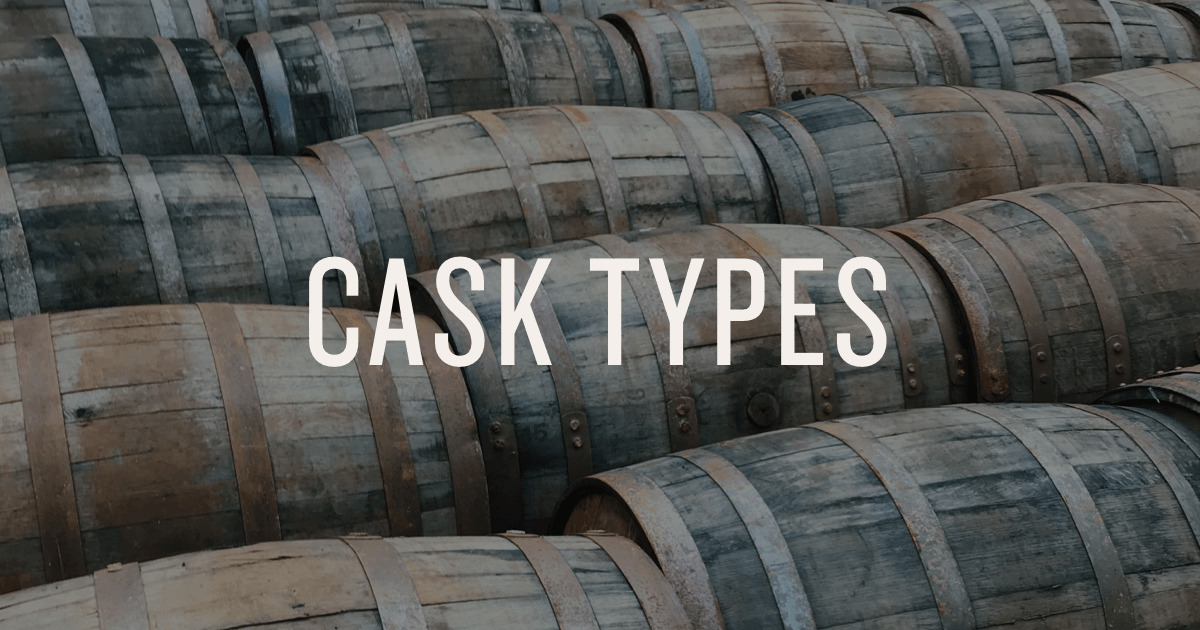
When it comes to aging American whisky, Quercus alba (white oak) has long been king. This native North American tree was in abundant supply when early distillers and merchants were looking for containers to store and ship their wares. It would have been more expensive and more trouble than it was worth to ship the barrels used to send whisky down the Mississippi River back up it, so new oak barrels continued to be manufactured and used for whisky aging.
By the 1960s the use of new barrels was fading, when the United States Government threw a gift to American coopers. In updating the standards of identity for Bourbon, they incorporated a requirement for the whisky to be stored in charred, new oak containers. Note that the American Oak is not specified, although it is usually seen as a given.
For the rest of the whisky world, many distilleries were delighted to take the used barrels from Bourbon production to use for aging their whiskies. Single malts in particular do well with a more gentle interaction with the wood, avoiding the harsher tannins found in new charred oak, although some American single malt producers desire a more wood forward expression and have used new oak in their maturation. Hillrock Estate’s single malt is initially aged in new charred oak barrels before moving to other barrels for finishing.
CASK VS BARREL: WHAT’S THE DIFFERENCE?
A cask is simply a large barrel shaped container, comprised of staves, headings, and hoops intended for holding liquid (usually alcoholic).
A barrel is at its broadest definition a shape - a container of greater length than breadth, that when used in the storing of alcohol is typically made of wooden staves joined with metal hoops and flat ends or heads. Other cylindrical containers made of materials such as plastic or metal may be called barrels or drums.
Some may use the two terms interchangeably, while others will argue that a barrel is a specific unit of measurement, which is correct in scenarios like a Bourbon barrel which are 50–53 gallon (180–200 liter) casks.
PERTAINING TO THE TOPIC OF BATCHES

When reaching for a bottle of whisky in a liquor store, you may notice a batch number on the bottle. This does not refer to the process of batch distillation, but rather serves as a way to denote a single bottling run of a whisky. This is more commonly seen with American whiskies, particularly Bourbons, but batch designations can be found in many categories including ryes and single malts. Some see the batch numbers as the whisky industry's answer to the concept of a vintage, due to the connection to specific years of production and aging in the whisky selected for a specific bottling.
The number of barrels used or the number of bottles produced in a single batch may vary widely. Even the term "small batch" is vague enough to carry no legal weight. It could mean two barrels or two hundred barrels were used. Varying batches of a whisky product typically demonstrate a level of consistency, while showing some changes in aroma, flavor or mouthfeel to varying degrees based on ingredients used, production processes and climate impacts.
PERTAINING TO THE TOPIC OF AGE STATEMENTS

Although age statements on a bottle of whisky are generally optional, the meaning of an age statement carries no room for debate: it always reflects the age of the youngest aged whisky component in the bottle. So, if a specific whisky is comprised of barrels that have aged 6, 8 and 12 years, the age statement must be 6 years. There are times when an age statement is mandated by government regulations. For example, the TTB (Alcohol and Tobacco Tax and Trade Bureau) requires American distilleries to disclose when a whisky is aged under four years.
This holds true for the recent ratification of the American Single Malt category, as there are no aging minimums, and the category works within the standard definitions of American Whisky.
Age statements were initially instituted to convey quality (and eventually exclusivity as a marketing strategy), but today’s whisky distillers and consumers are increasingly aware of the fact that aging from one country’s climate to another’s can be widely different. A whisky aged 50 years in the relatively consistent climate of Scotland might only lose 1% of its volume in a year, where a barrel of Bourbon aging in Kentucky, or a single malt aging in Virginia could very well be bone dry after 35 years. The color, aromas and flavors achieved in one year of aging whisky in Taiwan or Virginia could easily meet or exceed those achieved in three times that length in Scotland or Ireland. India has such an arid aging climate that a barrel of whisky could evaporate within just a few short years.
Cask finishing an already aged whisky does not count toward an age statement, even though evaporation and loss may still occur in these barrels. Whisky does not age in bottle, so a 12-year-old Scotch bottled in 1987 will still be a 12-year-old whisky if it’s opened today.
PERTAINING TO THE TOPIC OF PEAT

Peat is a natural substance made over thousands of years from decaying vegetation. The northern part of Scotland is abundant with peat, as it was part of the vast Caledonian Forest for many thousands of years. Islands such as Islay have an abundance of peat thanks to seaweed, moss and other decayed vegetation found along the islands’ coasts.
Some distilleries use peat as the heat source for drying the barley, which gives the whisky a deep, smoky, and at times medicinal flavor. Peat is measured by ppm (parts per million) and the intensity of peat notes in whisky is generally derived by the treatment of the peat and the amount of time the barley is exposed to the peat smoke as it dries.
A peated whisky will lead to notes of sea spray, iodine, seaweed, medicinal, band-aid, or even a green and earthy bitterness. Barrel smoke will lead to a cleaner smoky note reminiscent of an autumn campfire, charcoal, or even ash.
For American single malts aged in charred barrels, the smoky notes from that barrel char should be a nice addition to the whisky’s complexity, but should in no way overpower the spirit. Some producers like Westland Distillery have released a peated American single malt using a majority of non-peated malt in their barley bill to ensure the peat doesn’t dominate. Other distilleries, like Santa Fe Spirits, embrace the smoke and use mesquite smoke to allow barbecue aromas to reign supreme in their Colkegan Single Malt. Corsair Distillery’s Triple Smoke American Single Malt is another standout in the smoke category, thanks to their use of peat, smoked beechwood and smoked cherry wood in the malting process.
KEY PLAYERS IN THE AMERICAN SINGLE MALT CATEGORY
There are over 130 members of the American Single Malt Whiskey Commission, and over 200 distilleries in American making single malt (more than in Scotland!). With the recent ratification of the category, we expect more entrants to come to the category to purely make American Single Malt, and for some existing distilleries to introduce single malt to their range of offerings (examples: Jack Daniels, Bulleit, and High West.
Below is a list of several top key players in the category, followed by a secondary list of other notable single malt producers.
BALCONES DISTILLING
The Original Texas Whisky. Balcones Distilling is based out of Waco, TX and was founded in 2008. Their flagship American single malt product is Balcones “1” Texas Single Malt, but they also produce corn whisky, Bourbon, and rye whisky. Additionally, they have an array of annual and special releases in the single malt category, including various cask finishes and single barrel releases.
STRANAHAN'S
Stranahan's is based out of Denver, CO and was founded in 2004. Their flagship American single malt product is Stranahan's Original Single Malt Whiskey. They also release products under their Diamond Peak series (hand selected from some of their most distinct casks), their Sherry Cask expressions, and their popular limited-edition Snowflake Series released one day a year in December at their distillery.
WESTLAND DISTILLERY
Westland Distillery is based out of Seattle, WA and was founded in 2010. Their flagship American single malt product is American Oak Single Malt Whiskey, but they also produce expressions using peat and sherry wood. They’re well-known for their peat week, an annual week long celebration of their peated whiskey releases, in addition to other limited releases using Oregon white oak called Garryana. Westland Distillery is owned by Rémy Cointreau, a French spirits group known for their international portfolio.
WESTWARD WHISKEY
Founded in 2004, Westward Whiskey is based out of Portland, OR and is popularly known for their small batch American Single Malt Whiskey. Their flagship American single malt product is Westward American Single Malt, but they also produce an Oregon Stout Cask American single malt. In 2018, Westward Whiskey sparked interest from and announced an investment from Diageo through its Distill Ventures unit, with Westward maintaining majority ownership and independent control.
OTHER NOTABLE AMERICAN SINGLE MALT PRODUCERS

VIRGINIA DISTILLERY CO.
Based in Lovingston, VA and founded in 2011, we’re the largest independently-owned producer of American Single Malt whisky in the US. Our flagship offering Courage & Conviction American Single Malt Whisky was released in April 2020, along with new expressions released in March of 2021. We’re a proud founding member of the American Single Malt Whiskey Commission.
OTHER AMERICAN SINGLE MALT WHISKY RESOURCES

American Single Malt Whisky Commission (ASMWC) - formed in response to the growing need for American-based producers to define the category of American single malts. Here's a Twitter list we've created of all ASMWC members.
LIST OF AMERICAN SINGLE MALT RELATED PODCAST EPISODES
Single Malt Matters: The American Single Malt Whisky Podcast - A new and up-and-coming podcast about the people, culture and evolution of American single malt whisky. Every episode is devoted to the category of American single malt whisky. Click here to listen.
WhiskyCast: Cask Strength Conversation
- Episode 705: The First American Single Malt Whiskey? (6.10.2018)
- Episode 791: Terroir in Whiskey: Terrific Concept or Terrible Myth (11.3.2019)
The Spirit Guide Society
- Episode 58: Westland American Single Malt with Nathan Burdette (4.30.2019)
- Episode 92: Westward American Single Malt Whiskey with Christian Krogstad (8.27.2019)
Barrel to Bottle: The Binny's Podcast
Medium Plus: Elevated Wine and Cocktails
Manual Podcast: Beards, Booze, & Bacon
Drinks Adventures: A Podcast For Adventurous Drinkers
One Nation Under Whisky
Hear in Spirit
Lush Life
Chill Filtered
The Speakeasy
Email us at info@vadistillery.com if you have any other American single malt resources that you think should be added to this list.


